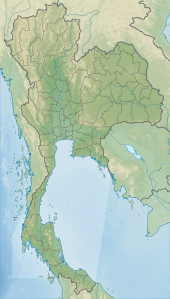Phu Phan National Park (Thai: ภูพานอุทยานแห่งชาติ) is a national park in Sakon Nakhon and Kalasin provinces, Thailand. This isolated park covers a wide jungle area in the Phu Phan Mountains of Isan.
| Phu Phan National Park | |
|---|---|
| ภูพานอุทยานแห่งชาติ | |
 Phra That Phu Pek | |
| Location | Sakon Nakhon and Kalasin provinces, Thailand |
| Nearest city | Sakon Nakhon |
| Coordinates | 17°3′45″N 103°58′22″E / 17.06250°N 103.97278°E |
| Area | 665 km2 (257 sq mi) |
| Established | 13 November 1972 |
| Visitors | 4,895 (in 2019) |
| Governing body | Department of National Parks, Wildlife and Plant Conservation |
Geography edit
Phu Phan National Park is located 25 kilometres (16 mi) south west of Sakon Nakhon town and about 25 kilometres (16 mi) north of Kalasin. The park's area is 415,439 rai ~ 665 square kilometres (257 sq mi).[1]
History edit
In the past, the isolation of the park's location led to its use for cover by some military groups. During World War II, the Seri Thai resistance fighters used the Tham Seri Thai cave for weapons storage. And in the 1970s the People's Liberation Army of Thailand (PLAT) used the area as a hideout.[2]
Attractions edit
Viewpoints in the park include the west-facing Nang Mern Cliff and the Lan Sao Aee plateau.[2]
The park has numerous waterfalls, including the multi-stage Kam Hom Waterfall, also Kreng Ka-arm and Pree-cha Suk-san waterfalls.[3]
Some of the park's unusual rock formations include the grilled-snake-shaped Khong Ping Ngu and the 8 metres (26 ft) long Tang Pee Parn natural stone bridge.[2]
The park also contains the ruins of a Khmer temple, Phra That Phu Pek, accessed by ascending around 500 steps.[3]
Flora and fauna edit
The park consists of seasonal tropical forest, with a large dry dipterocarp forest component. Other forest tree types here are dry evergreen and mixed deciduous.[4] Tree species include Dalbergia cochinchinensis, Pterocarpus macrocarpus, Shorea roxburghii, Afzelia xylocarpa, Hopea odorata, Dipterocarpus alatus, Dipterocarpus obtusifolius, Dipterocarpus tuberculatus, Shorea obtusa, Terminalia alata, Irvingia malayana, Shorea siamensis, Lagerstroemia calyculata, Tetrameles nudiflora, Xylia xylocarpa Peltophorum dasyrhachis and Dillenia obovata.[3]
Animal species include tiger, Phayre's leaf monkey, sambar deer, fishing cat, Sunda flying lemur, Malayan porcupine, common palm civet, northern red muntjac and wild boar.[3] Bird species include black drongo, hill myna, Richard's pipit and white-rumped shama.[3]
See also edit
References edit
- ^ "ข้อมูลพื้นที่อุทยานแห่งชาติ ที่ประกาศในราชกิจจานุบกษา 133 แห่ง" [National Park Area Information published in the 133 Government Gazettes]. Department of National Parks, Wildlife and Plant Conservation (in Thai). December 2020. Retrieved 1 November 2022, no 7
{{cite web}}: CS1 maint: postscript (link) - ^ a b c Williams, China; Beales, Mark; Bewer, Tim (February 2012). Lonely Planet Thailand (14th ed.). Lonely Planet Publications. pp. 492. ISBN 978-1-74179-714-5.
- ^ a b c d e "National Parks in Thailand: Phu Phan National Park" (PDF). Department of National Parks (Thailand). 2015. pp. 148–149. Retrieved 29 May 2017.
- ^ "Phu Phan National Park". Department of National Parks (Thailand). Archived from the original on 22 May 2013. Retrieved 19 April 2013.
